One stormy night, camping beside the Pacific Ocean sand dunes south of Pismo Beach, I woke up to a terrible racket. I ran outside and saw that one of the guy lines to my awning had broken loose and the awning was partially collapsed and some of the lights strung across the opening had broken. I grabbed onto the guy line/strap, and saw that the tent stake securing it had been pulled up from the sand. The horrific offshore winds were almost taking me airborne as I held tight to the strap that was attached to the awning, which suddenly seemed like a big parachute, and I wondered what to do. Wind and rain whipped about. Putting another stake into the sand was stupid.
I looked down. My dog had followed me out and huddled close in this 3 a.m. gale, the awning flapping something awful, sideways rain stinging our eyes. She looked up at me and we had the same thought: WHAT ARE WE GOING TO DO????
I realized that if I tied a rope to lengthen the guy line from the awning, I could tie it to the split-rail fencing at the edge of camp, thus anchoring it. Afterward, wet and rattled, we got back in the trailer and made it through the night. The next day I heard some women talking outside my window, saying: “What the heck was that wind all about last night?”
I’m beginning to realize that wind is hard to predict.

A month ago I was sitting under my awning on a warm afternoon in the high desert and the wind was whipping the awning’s fabric. The tent fabric was popping back and forth, the tapestry clipped along the front was swaying to and fro. I glanced across the dry riverbed to giant pine and eucalyptus trees. Their tops were swaying.
I thought: “I don’t recall any high-wind predictions.” I figured the current wind was about 18 to 20 mph. So I logged onto The Weather Channel and it indicated the wind speed here is 8 mph. I call BS on that!
In my experiences as a full time camper, wind becomes an issue at about 15 to 20 mph, and really becomes a problem around 30 mph and above. At that point, I’m likely to remove the awning and tent and retreat to the T@B. But that’s rare.

I notice the wind these days, but here’s how I’ve changed over the months I’ve been a full-time camper: I am not worried about the wind knocking down my camp. At this point, it’s just wind. It’s not t a threat to my life and well-being.
Eight months ago, just starting out, I didn’t understand how to set up a wind-resistant camp. I often found the various parts and pieces of my camp coming loose, flailing about, falling over, breaking, flying away. I just didn’t know what I was doing.
Happily, nothing inside my T@B trailer is affected by wind. In fact, while inside the trailer I have virtually no awareness of wind. My trailer is so small and rounded that the wind just goes around it and doesn’t buffet it around. But with all the extra spaces I set up outside with tents and awnings (because my mental health depends on being outside a lot, rather than inside an RV all the time), the wind must be dealt with.
Here are some wind strategies I’ve developed:
Lots of superior tent pegs—In areas of no wind, my awning can function without many tent pegs on each of the points that contact the ground. But with a little wind, the awning shifts around. So I take out my big bag with my tent pegs and my hammer and I do the job. I use big and hearty pegs that I’ve picked up along the way, and sometimes put two hearty pegs in each location, driven down in opposite directions. Note to self: I need to invest in Peggy Pegs, which are made for sand and which are applied using a drill. Another note to self: I need to divest myself of the lame little pegs that have come with my various tents and awnings. They are not worth their weight.

Using the picnic table for an anchor—The three main points of contact for my awning need to be staked to something solid, usually the ground. But when there are three stakes and lead lines on the front of my trailer, that causes a lot of tripping and dog leash tangling. Plus, the stakes can pull up in sandy soil in high winds. Lesson learned. So I have discovered over the months that if I push the heavy campsite picnic table up close to the outer perimeter of the awning, I can tie two of the three straps to the table or bench, using the slipknot my mariner friend taught me. That leaves half of the front of the awning open for coming and going and for the view. I typically hang a tapestry between the table and the awning for privacy and to hide my computer and the 2 ft. by 4 ft. folding table it lives on.


Clipping the awning to dog fencing—I’ve developed the habit of installing dog fencing around the front of my trailer so that my dog has a little yard. I then discovered that if I use my awesome spring clamps to clip the fencing to the trailer and to the sides of the awning, and clip the awning to the picnic table, I’ve created quite a sturdy assemblage.

. I did that, and haven’t had a breakage since.
In the months between my complete ignorance and the time when I became wind savvy, my camping experiences were often accompanied by the stress of the wind. Will something fall over? Will something break? Will something collapse? As I have slowly learned to “harden” my camp against wind, I realize the tension inside me is gone. Of course, a lot of wind can be very irritating. I’m often in a windy area because my sister lives there, and she lives there because that’s where her husband found work back in the day. So while some wise guy on a FB forum for full-time RVers might say: “Just move to a different area,” that doesn’t quite work. I do enjoy when I’m in less windy areas, but for me, conquering the wind has been a marvelous solution.
Still, I need to get my own wind-measuring device, and one that will determine the direction. The forecasters might not be able to figure this out, but at least I will know what’s going on minute by minute and not just be out here flapping in the wind with no plan, and no protection.

This morning, 7,000 feet high in the California mountains, the air is still, but who knows what will happen in the next few hours? It’s not a stressor for me because I now set up every camp hardened against potential wind. With all my knowledge, strategies, and labor to conquer wind, “I don’t give it no never mind,” as they would say in the South. And that’s a good feeling.
Note: I am a participant in the Amazon Services LLC Program, an affiliate advertising program. If you purchase something through the links on this page, I earn a small commission at no cost to you. Thank you!
